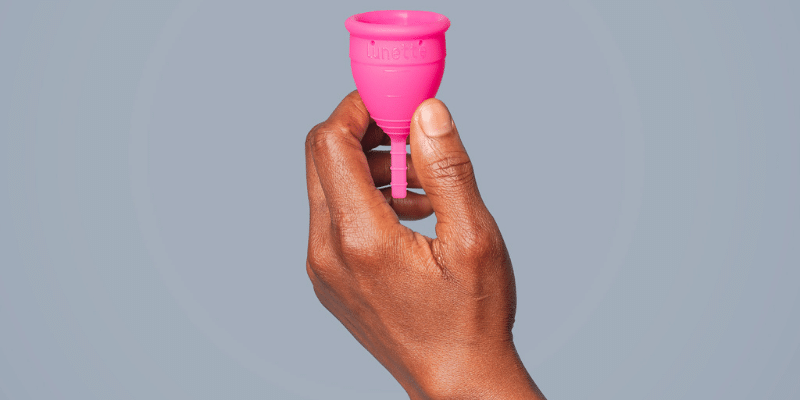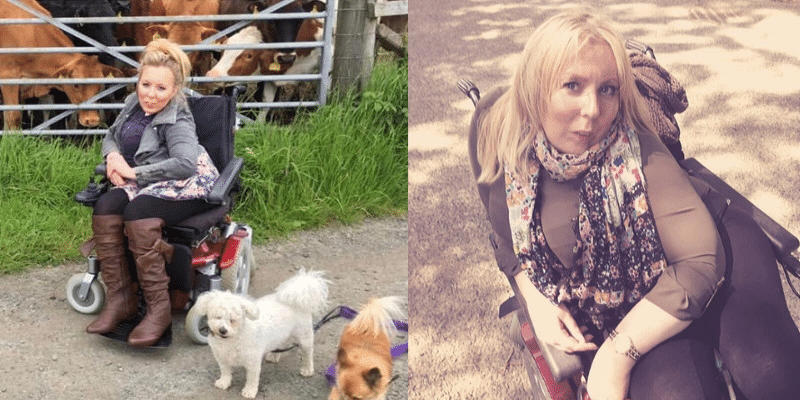Using a Menstrual Cup
when disabled
We know that periods are personal, and changing your period care routine can seem daunting, especially if you have extra needs to consider.
In 2020 we conducted a small survey on ‘Periods and Disability’ which found that 2 in 5 people are dissatisfied with the period care products they currently use. Of those who aren’t happy with their period care products, 88% are using big-brand tampons and 42% are using big-brand pads.
There was an overwhelming and unanimous call for more information and personal stories about period products through the lens of disability, conditions and impairments. So we’re starting by offering a more in-depth insight into what it’s like to try a menstrual cup for the first time – a period care product that lasts up to 10 years, is plastic-free and toxic chemical-free.
Before we dive into Katie’s experience, let’s cover some of the basics…

What is a menstrual cup?
Menstrual cups are soft, flexible cups made of medical-grade silicone, TPE or latex rubber. Menstrual cups are worn internally, by folding and inserting the cup in a similar way to a tampon. Instead of absorbing your blood, like a tampon or pad, the cup catches it and you can empty it down the toilet. Menstrual cups hold more blood than your average tampon so you shouldn’t need to empty it as regularly as you would change a tampon (but make sure you do not exceed brand recommendations on length of wear as you still risk TSS).
No one is a pro at using a menstrual cup at the beginning! It takes practice to nail inserting and removing the cup, and because it doesn’t dry you out like a tampon, this can be done in the shower and/or between periods if you want to speed up the process.
What to consider when buying a menstrual cup
All cup brands are different so do some research and work out the best option for you. Each brand usually has a few options that differ in size, shape and rigidity, which will suit different lifestyles, flows and bodies.
You want to make sure that your cup is made of medical-grade silicone, medical-grade latex or medical-grade TPE, as well as BPA-free. Cups that do not mention it in their packaging probably include some nasties, including plastic!
To find out more about how to insert and remove a menstrual cup, menstrual cup maintenance, what to do when travelling, using one with an IUD, and much more, head over to our FAQ’s page or Lunette’s website.
Finally, menstrual cups are not for everyone – they do require a certain level of dexterity and mobility and/or for you to be comfortable with a carer or PA inserting and removing it. If you have limited sensation around the vagina it can be difficult to insert the cup properly, which might mean you experience leaks. Choosing a period product is all about knowing your body and doing your research.
Without further ado, let’s meet Katie who trialled a Lunette menstrual cup for 3 months.

Hi Katie, let’s start with an introduction to you.
Hello! I’m Katie-May, I’m 39, I have Muscular Dystrophy and use a wheelchair. My interests are my two beautiful dogs, learning to use Adobe Illustrator and creating digital art. I love to read personal development books and occasionally binge a box set on Netflix.
How would you describe your current experience of having a period?
My periods are difficult due to limited mobility – using a tampon is hard but keeping a pad in place is harder. I’m unable to get on the toilet and due to limited care resources I can only use the toilet 1-2 times a day, so I use a catheter instead.
I’m currently using a popular brand of tampon for heavy periods. I don’t really like using tampons because I feel like they harbour bacteria and I’m only able to change my tampon every 12 hours. The possibility of toxic shock is a big concern for me.
What made you decide to try a Lunette menstrual cup?
I decided to try the menstrual cup because it’s a healthier option for my body, it’s cleaner and safer. It can hold more than a tampon, which means I can use it for 12 hours with less chance of my clothes getting in a mess. It’s reusable, so it reduces waste and is better for the environment.
And a bonus is that I will save a lot of money not buying tampons every month!
How are you feeling about trialling the cup for 3 months?
The mobility in my hands is very limited, so I’m apprehensive about struggling with using the cup, however, I’m confident that I’ll adapt, and make it work. Overall, I’m excited to start using it and I’m hoping it will take away a lot of stress that comes with my periods.
Let’s throwback for a moment – what kind of education did you receive at school about periods? What do you think about the quality of that education?
I didn’t receive much in a way of education about periods in school. We were told how often we would have a period, that it would only be a teaspoon amount of blood and that we were to use pads. I wasn’t prepared at all for my period starting!
I hope that children are more educated on periods than I was and I hope that schools educate children about menstrual cups and other environmentally-friendly alternatives that are also healthier for our bodies.
Were you previously aware of the amount of plastic and chemicals used in big-brand tampons and pads?
I’m aware that pads contain a certain amount of plastic but I’ve never really used them because I find them messy and uncomfortable to wear. I’m shocked to learn that tampons are 6% plastic! I knew that tampons were wrapped in plastic and some have plastic applicators but not that the actual tampons contained plastic too!
Now you’ve had 3 months to give the Lunette cup a go, tell us a bit about how you found using it?
My experience with the menstrual cup has been positive. It takes a little time for me to get my hand positioned to use it and it can be a little slippery with the lube but I’m getting around it with my partner or carer supporting my hand. Once it’s in, it’s brilliant!
I’m amazed at how much it holds and I’ve had no leaks either. I don’t have the strength to remove the cup but my partner or carer helps with that by pulling my hand as I grip onto it, which is pretty much what we do with a tampon.
It’s been nice to know that support is available through Lunette’s customer service team if I need it.
What are the pros and cons of the menstrual cup for you?
The pros of using the menstrual cup are: less chance of toxic shock; it can be worn for up to 12 hours; I don’t know if it’s connected but I haven’t had severe cramps with the menstrual cup like I used to with tampons; once the cup is in I didn’t really feel it, whereas a tampon can feel uncomfortable after a while.
There wasn’t really any cons to using the cup apart from it can be a little tricky to insert and I needed help to do it but I often have the same problem with a tampon and this is due to my reduced mobility.
Did using the cup affected your daily activities at all?
If anything the cup has improved my daily activities. I no longer have leaking from tampons, so I don’t have to sit in wet clothes or bother family to come and change my wet clothes.
The menstrual cup is a life-changing product for someone with a disability who is unable to change their period products regularly. I wish I’d tried it sooner. It’s safer, healthier, and cleaner. It gives me so much more freedom and peace of mind that I’m not going to get sick from period products.
We’re over the moon to hear that the cup has so drastically improved your period experience! Do you think you’ll continue to use it?
Yes for sure, there’s no going back for me now!
Would you recommend a menstrual cup to a friend or family member?
Yes I would recommend using a menstrual cup to family and friends, especially to my younger cousins. I want them to be safe and protected by their period products, as well as us all doing our part for the environment.
Thank you for being part of this project Katie, it’s been great talking to you!
Now that there are so many period product choices out there, we want to help make sure that the information you need is available so you can make an informed decision about what is best for your needs, your body and your lifestyle.
If you want to see more of our content on periods and Disability:
- Watch our Panel Event ‘Periods and Disability’, featuring 5 amazing panellists discussing their experiences of various conditions and impairments, periods, sex education, stigma and more. Read the event summary and watch the recording here.
- Download our new period product guide for additional needs, also available in word format.
- Use the code CITYTOSEA15 for 15% off at Mooncup
- You can find 4 personal stories we collected for Disability Awareness Day here:

